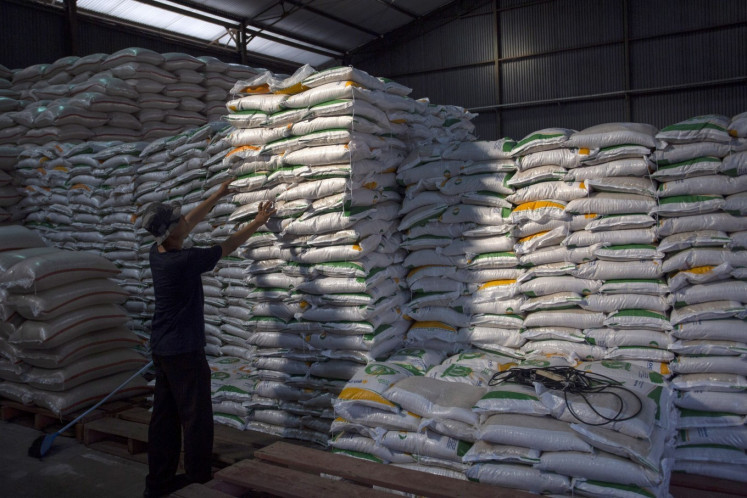Popular Reads
Top Results
Can't find what you're looking for?
View all search resultsPopular Reads
Top Results
Can't find what you're looking for?
View all search resultsHow the Arab uprisings were weakened by online fakes
As pro-regime media pumped out misinformation, the flood of bogus news also spread to the internet, a space activists had long seen as a refuge from censorship and propaganda.
Change text size
Gift Premium Articles
to Anyone
 In this file photo taken on Jan.19, 2011, a protester records with his mobile phone a demonstration in central Tunis. Social media and smartphones briefly gave youthful Arab Spring protesters a technological edge that allowed them to topple ageing dictatorships as their revolutionary spirit went viral. Regimes across North Africa and the Middle East were caught flat-footed a decade ago as the fervor of the popular uprisings spread at the speed of the internet via Facebook, YouTube and Twitter. Unfortunately for the pro-democracy movements, autocratic states have since caught up in the digital arms race, adding cyber surveillance, online censorship and troll armies to their arsenals.
(AFP/Fred Dufour)
In this file photo taken on Jan.19, 2011, a protester records with his mobile phone a demonstration in central Tunis. Social media and smartphones briefly gave youthful Arab Spring protesters a technological edge that allowed them to topple ageing dictatorships as their revolutionary spirit went viral. Regimes across North Africa and the Middle East were caught flat-footed a decade ago as the fervor of the popular uprisings spread at the speed of the internet via Facebook, YouTube and Twitter. Unfortunately for the pro-democracy movements, autocratic states have since caught up in the digital arms race, adding cyber surveillance, online censorship and troll armies to their arsenals.
(AFP/Fred Dufour)
T
he Arab uprisings a decade ago were supercharged by online calls to join the protests - but the internet was soon flooded with misinformation, weakening the region's cyber-activists.
When Tunisian dictator Zine El Abidine Ben Ali fled the country in January 2011, rumors and uncertainty created "panic and hysteria", said ex-activist and entrepreneur Houeida Anouar.
"Jan.14 was a horrible night, so traumatic," she said. "We heard gunfire, and a neighbor shouted 'hide yourselves, they're raping women'."
As pro-regime media pumped out misinformation, the flood of bogus news also spread to the internet, a space activists had long seen as a refuge from censorship and propaganda.
Journalist and researcher Hakim Beltifa said the ground was ripe for "the spreading of fake news".
"Fake news fed off people's mistrust" of traditional, state-owned media outlets which "obscured the reality and kept the people in ignorance," he wrote for online magazine The Conversation.
When Egyptian state TV accused American fast food chain Kentucky Fried Chicken of giving free meals to pro-democracy protesters at Cairo's emblematic Tahrir Square, the rumors were repeated online, amid a string of reports of foreign powers allegedly infiltrating the protest movement.
But activists and journalists on the ground found little evidence of fried chicken. Most demonstrators were getting by on pita bread and kushari, a popular, ultra-cheap street dish of rice, pasta and lentils.
Soon, a slew of fake stories originating online was undermining trust in internet sources. One example was the infamous case of the "Gay Girl of Damascus".
Amina Abdallah Arraf was a young Syrian-American lesbian, anti-regime activist and author of a blog widely followed by observers of the Syrian uprising.
Except she never existed.
When Amina was reported "kidnapped" in Damascus, her worried followers mobilized to rescue her from the hands of the Assad regime.
But they discovered that the blogger, who had been an icon of Syria's pro-democracy movement, was in fact Tom MacMaster - a bearded American in his 40s living in Scotland and hoping to achieve some literary fame.
"That seems fairly bland today as we've learned to be more suspicious of this type of fabrication, but at the time, suspicion was far less prevalent," researcher Yves Gonzalez Quijano said.
Another invented personality was Liliane Khalil, supposedly a US journalist covering the "Arab Spring" for a number of media outlets, and who had indirectly expressed support for the Bahraini government.
Despite a mass of public information about Khalil, who was accused by many activists and researchers of being a fake, her true identity has never been revealed.
The two cases, with their carefully-crafted back stories and manipulated images, were early examples of what soon became a trend of misinformation online.
Researcher Romain Lecomte said that regimes were soon able to "infiltrate discussions" online, spread doubt about reported abuses and "sow confusion and misinformation".
"Mass political use of the internet" was a game-changer, said Lecomte.
Many online activists began to question the democratic power of the internet.
That has sparked the phenomenon of fact-checking services, along with dilemmas about whether to allow "fake news" to flourish or to censor it and risk compromising democratic freedoms.
In the early years of the Arab uprisings, chat rooms and sites such as Lina Ben Mhenni's blog "A Tunisian Girl" had fueled growing protest movements and side-stepped censorship.
But the flood of misinformation took away much of the credibility of cyber-activism, said Gonzalez Quijano.
It "has never recovered from being used, or rather manipulated, by political powers that are better organized than activists on the ground," he said.









